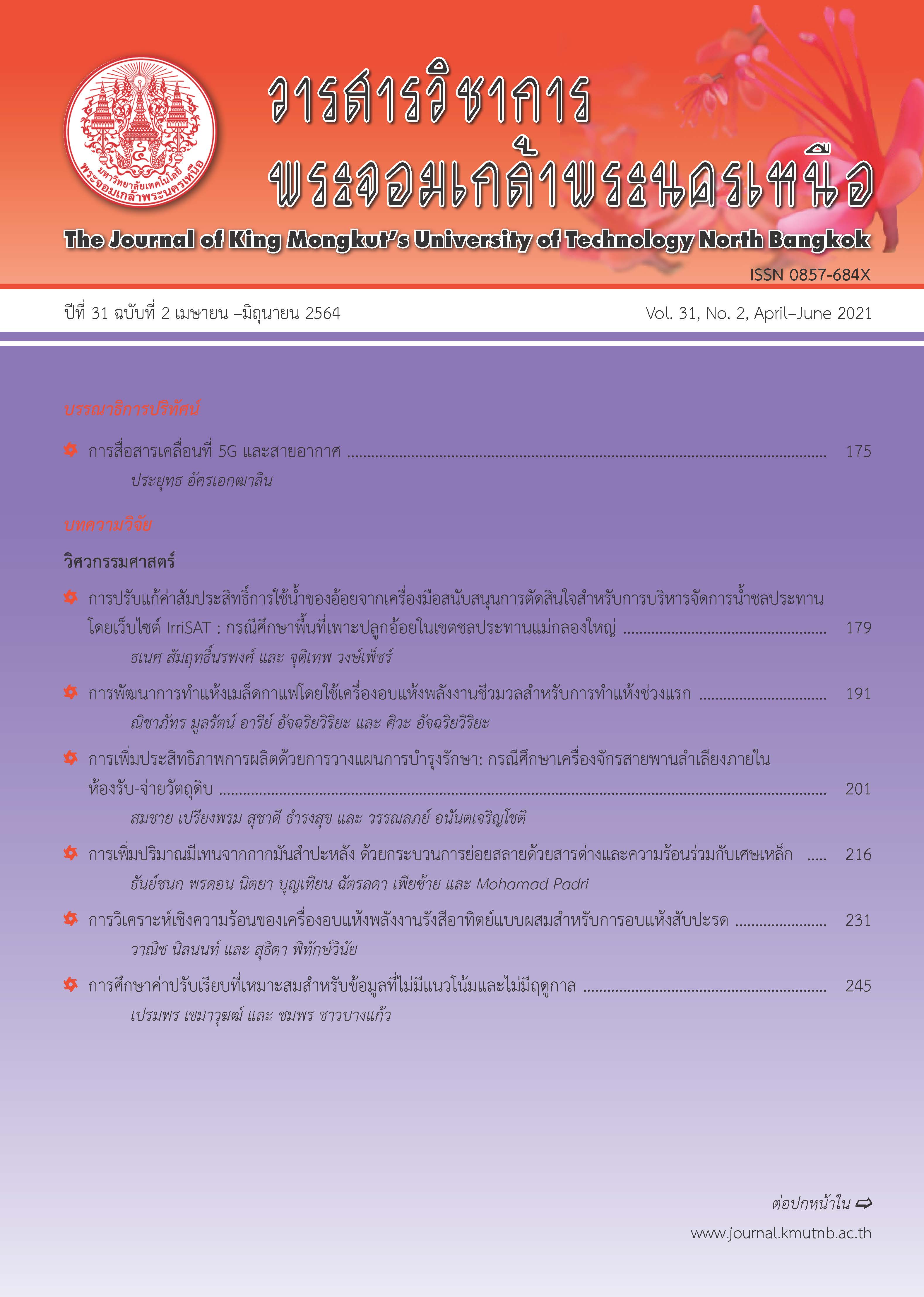ผลของสารละลายแคลเซียมไฮดรอกไซด์ต่อกำลังอัดของมอร์ตาร์ที่ใช้เถ้าถ่านหินปริมาณสูงเป็นวัสดุประสาน
Main Article Content
บทคัดย่อ
วัตถุประสงค์ของการวิจัยนี้เพื่อศึกษาผลของความเข้มข้นของสารละลายแคลเซียมไฮดรอกไซด์ (Ca(OH)2) ต่อกำลังอัดของมอร์ตาร์ที่ใช้เถ้าถ่านหินปริมาณสูงเป็นวัสดุประสาน โดยแทนที่เถ้าถ่านหินในปูนซีเมนต์ปอร์ตแลนด์ประเภทที่ 1 ร้อยละ 70, 80 และ 90 โดยน้ำหนักวัสดุประสาน และใช้สารละลายแคลเซียมไฮดรอกไซด์ ที่เข้มข้นเท่ากับร้อยละ 0, 5, 10, 15 และ 20 โดยน้ำหนัก ผสมในมอร์ตาร์เพื่อเป็นสารเร่งปฏิกิริยาปอซโซลาน ผลการศึกษาพบว่า การใช้ปริมาณเถ้าถ่านหินแทนที่ปูนซีเมนต์ปอร์ตแลนด์ประเภทที่ 1 ในปริมาณที่มากขึ้น ส่งผลให้กำลังอัดของมอร์ตาร์ลดลง โดยเฉพาะในช่วงอายุต้นของการบ่ม อย่างไรก็ตามการใช้สารละลายแคลเซียมไฮดรอกไซด์ ที่มีความเข้มข้นไม่เกินร้อยละ 10 โดยน้ำหนัก เร่งปฏิกิริยา ส่งผลให้กำลังอัดของมอร์ตาร์สูงขึ้น โดยเฉพาะที่อายุบ่มที่นานขึ้น โดยการใช้สารละลายแคลเซียมไฮดรอกไซด์ ที่มีความเข้มข้นเท่ากับร้อยละ 5 และ 10 โดยน้ำหนัก ในมอร์ตาร์ที่ใช้เถ้าถ่านหิน ร้อยละ 80 และ 90 โดยน้ำหนักวัสดุประสาน สามารถเพิ่มกำลังอัดในมอร์ตาร์ได้มากกว่าส่วนผสมที่ไม่ได้ใช้สารละลายแคลเซียมไฮดรอกไซด์ ถึงร้อยละ 32 และ 37 ตามลำดับ
Article Details
บทความที่ลงตีพิมพ์เป็นข้อคิดเห็นของผู้เขียนเท่านั้น
ผู้เขียนจะต้องเป็นผู้รับผิดชอบต่อผลทางกฎหมายใดๆ ที่อาจเกิดขึ้นจากบทความนั้น
เอกสารอ้างอิง
[2] B. Ma, X. Liu, H. Tan, T. Zhang, J. Mei, H. Qi, W. Jiang, and F. Zou, “Utilization of pretreated fly ash to enhance the chloride binding capacity of cement-based material,” Construction and Building Materials, vol. 175, pp. 726–734, 2018.
[3] K. Muthusamy, J. Mirza, N. A. Zamri, M. W. Hussin, A. P. P. Abdul Majeed, A. Kusbiantoro, and A. M. Albshir Budiea, “Properties of high strength palm oil clinker lightweight concrete containing palm oil fuel ash in tropical climate,” Construction and Building Materials, vol. 199, pp.163–177, 2019.
[4] H. M. Hamada, G. A. Jokhio, F. M. Yahaya, A. M. Humada, and Y. Gul, “The present state of the use of palm oil fuel ash (POFA) in concrete,” Construction and Building Materials, vol. 175, pp. 26–40, 2018.
[5] U. Chatveera and P. Srinourn, “A study of properties of mortar portland cement type V mixed with ground rice husk ash and limestone powder,” KMUTT Research and Development Journal, vol. 35, no. 2, pp. 201–218, 2012 (in Thai).
[6] P. Chindaprasirt and C. Jaturapitakkul, “Cement, pozzolan and concrete,” Thailand Concrete Association, pp. 11–13, and pp. 238–240, 2008 (in Thai).
[7] C. Shi and RL. Day, “Comparison of different methods for enhancing reactivity of pozzolans,” Cement and Concrete Research, vol. 31, no. 5, pp. 813–818, 2001.
[8] Standard Specification for Portland cement, ASTM Standards C 150-07, 2019.
[9] Standard Specification for Coal Fly Ash and Raw or Calcined Natural Pozzolan for Use in Concrete, ASTM Standards C618-19, 2019.
[10] V. Sata, C. Jaturapitakkul, and K. Kiattikomol, “Influence of pozzolan from various by-product materials on mechanical properties of highstrength concrete,” Construction and Building Materials, vol. 21, no. 7, pp. 1589–1598, 2007.
[11] P. Chindapasirt, C. Jaturapitakkul, and T. Sinsiri, “Effect of fly ash fineness on compressive strength and pore size of blended cement paste,” Cement and Concrete Composites, vol. 27, no. 4, pp. 425–428, 2005.
[12] R. Soeurt and W. Chalee, “Compressive strength improvement of concrete containing rice husk ash using an alkaline activator,” The Journal of KMUTNB, vol. 26, no. 3, pp. 347–357, 2016 (in Thai).
[13] R. Soeurt and W. Chalee, “The influence of NaOH concentration on compressive strength of fly ash concrete,” The Journal of KMUTNB, vol. 27, no. 4, pp. 737–749, 2017 (in Thai).
[14] M. Thomas, Optimizing the use of fly ash in concrete, Portland Cement Association, IS. 548, 2007, pp. 1–24.

